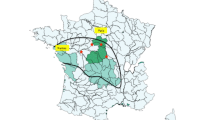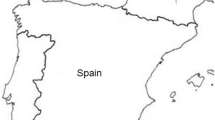Abstract
Polychlorinated biphenyls (PCBs), cis-chlordane, oxychlordane, heptachlor epoxide, mirex, hexachlorobenzene (HCB), lindane, octachlorostyrene (OCS), p,p′-DDE,p,p′-DDT, dieldrin, triphenylphosphate (TPP), polybrominated biphenyls (PBBs), and polybrominated diphenyl ethers (PBDPEs) were measured in the blubber, and five metals (mercury, lead, cadmium, chromium, and manganese) and selenium were measured in the liver of bottlenose dolphins (Tursiops truncatus) obtained from the Gulf of Mexico during an unusual mortality event in 1990. The collection of animals included fetuses, sucklings (<1 year old), immature dolphins (2–5 years old), and adults of both sexes. PCBs, p,p′-DDE, HCB, and PBDPEs were detected in the blubber of each animal. Mean concentrations of organic contaminants were generally highest in adult males. p,p′-DDE was the single component analyte measured at the highest concentration. Immature females had greater concentrations of most chlorinated organics than adult females. Mercury and cadmium concentrations in liver increased with increasing age-class. The correlation between mercury and selenium in all animals was r=0.96, with a mole ratio of 0.90. Concentrations of lead, manganese, cadmium, and chromium did not follow any particular age-class trend.
Similar content being viewed by others
References
Brody M (1989) Explaining sea mammal deaths proves challenging. J Am Soc Microbiol 55:595–598
Brouwer A, Reijnders PJH, Koeman JH (1989) Polychlorinated biphenyl (PCB) contaminated fish induces vitamin A and thyroid hormone deficiency in the common seal (Phoca vitulina). Aquatic Toxicol 15:99–106
Geraci JR (1989) Investigation of the 1987–88 mass mortality of bottlenose dolphins along the U.S. Central and South Atlantic coast. Final report to National Marine Fisheries Service and U.S. Navy, Office of Naval Research and Marine Mammal Commission, Washington DC, January, 1989
Hatch WR, Ott WL (1968) Determination of sub-microgram quantities of mercury by atomic absorption spectroscopy. Anal Chem 40:2085–2087
Kendall MD, Safieh B, Harwood J, Pomeroy PP (1992) Plasma thymulin concentrations, the thymus and organochlorine contamination levels in seals infected with phocine distemper virus. Sci Total Environ 115:133–144
Koeman JH, Peeters WHM, Koudstaal-Hol CHM, Tijoe PS, deGoeij JJM (1973) Mercury-selenium correlations in marine mammals. Nature 245:385–386
Koeman JH, von de Ven WSM, deGoeij JJM, Tjioe PS, van Haaften JL (1975) Mercury and selenium in marine mammals and birds. Sci Total Environ 3:279–287
Kuehl DW, Leonard EN (1978) Isolation of xenobiotic chemicals from tissue samples by gel permeation chromatography. Anal Chem 50:182–185
Kuehl DW, Haebler R, Potter C (1991) Chemical residues in dolphins from the US Atlantic coast including Atlantic Bottlenose obtained during the 1978/88 mass mortality. Chemosphere 22(11):1071–1084
—, —, — (1994) Coplanar PCB and metal residues in dolphins from the U.S. Atlantic coast including Atlantic bottlenose obtained during the 1987/88 mass mortality. Chemosphere 28(6):1245–1253
Lahvis GP, Wells RS, Kuehl DW, Stewart JL, Rhinehart HL, Via CS (1994) Decreased in vitro lymphocyte responses in free-ranging bottlenose dolphins (Tursiops truncatus) are associated with increased whole blood concentrations of polychlorinated biphenyls (PCBs), p,p′-DDT, p,p′-DDE, and p,p′-DDE. Environ Hlth Per (in press)
National Oceanic and Atmospheric Administration (NOAA) (November, 1992) Report on investigation of 1990 Gulf of Mexico Bottlenose Dolphin Strandings. MIA-92/93–21, LJ Hansen, ed., NMFS, SFSC, Miami, FL
Rawson AJ, Patton GW, Hofmann S, Pietra GG, Johns L (1993) Liver abnormalities associated with chronic mercury accumulation in stranded bottlenose dolphins. Ecotoxicol Environ Safety 225:41–47
Safe S (1992) Development, validation, and limitation of toxic equivalency factors. Chemosphere 25:61
Scott GP, Burn DM, Hansen LJ (1988) The dolphin dieoff: Long-term effects and recovery of the population. Proceedings of the Oceans '88 Conference, Baltimore, MD, October 31–November 2, 1988
Tanabe S (1988) PCB problem in the future: Foresight from current knowledge. Environ Pollut 50:5
United States House of Representatives (USHR) (1989) Mass mortality of bottlenose dolphins in 1987–1988. Hearings before the subcommittee on Oversight and Investigation of the Committee on Merchant Marine and Fisheries Serial No. 101-20. The conclusions of the clinical investigation of the 1987–88 mass mortality on bottlenose dolphins along the United States Central and South Atlantic coasts. Washington, DC, May 9
Vos JG, de Roij T (1972) Immunosuppressive activity of a polychlorinated biphenyl preparation on the humoral immune response in guinea pigs. Toxicol Appl Pharmacol 21:549
Author information
Authors and Affiliations
Rights and permissions
About this article
Cite this article
Kuehl, D.W., Haebler, R. Organochlorine, organobromine, metal, and selenium residues in bottlenose dolphins (Tursiops truncatus) collected during an unusual mortality event in the Gulf of Mexico, 1990. Arch. Environ. Contam. Toxicol. 28, 494–499 (1995). https://doi.org/10.1007/BF00211632
Received:
Revised:
Issue Date:
DOI: https://doi.org/10.1007/BF00211632




